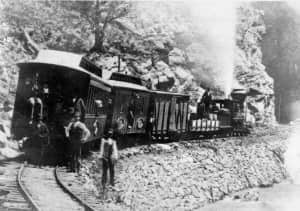Nineteenth-century America was not a libertarian utopia
By Kristopher A. Nelson
in
May 2012
900 words / 4 min.
Tweet
Share
There is a commonly held perception that the United States in the nineteenth century lacked rules and regulations that we today commonly associate with intrusive “big government.”

Please note that this post is from 2012. Evaluate with care and in light of later events.
 There is a commonly held perception that the United States in the nineteenth century lacked rules and regulations that we today commonly associate with intrusive “big government.” This trope holds that, instead, the nineteenth century was “an age of private contract and public constitutional limitations” (Novak 12). Libertarians like Jacob G. Hornberger write:
There is a commonly held perception that the United States in the nineteenth century lacked rules and regulations that we today commonly associate with intrusive “big government.” This trope holds that, instead, the nineteenth century was “an age of private contract and public constitutional limitations” (Novak 12). Libertarians like Jacob G. Hornberger write:
The principles are simple to enumerate: No income taxation (except during the Civil War), Social Security, Medicare, Medicaid, welfare, economic regulations, licensure laws, drug laws, immigration controls, or coercive transfer programs, such as farm subsidies and education grants. – Jacob G. Hornberger, “Liberal Delusions about Freedom“
He notes, too, the lack of regulatory agencies like the EPA and OSHA, and the right for everyone “to pursue an occupation or trade without seeking the permission of the government.”
The first, and simplest response to this, of course, is “who is ‘everyone'”? African-Americans were mostly enslaved until after the Civil War – were they free “to pursue an occupation or trade”? Did the Jim Crow laws of the late nineteenth-century South provide extra liberty for those former slaves?
Women could not vote and were – at various times, more or less – the property of their husbands. Were they “free”? (See David Boas, “Up from Slavery,” for more on this.) Thus, any nineteenth-century libertarian “utopia” is immediately undermined by the lack of freedom for so many.
But beyond this simplistic and obvious critique lies a deeper reality: Americans in the nineteenth century did not live without rules, regulations, and laws, and did not rely strictly on private contract and personal responsibility to conduct business or to handle social relations.
William J. Novak, in The People’s Welfare: Law and Regulation in Nineteenth-Century America, writes:
[It] was a public society in ways hard to imagine after the invention of twentieth-century privacy. Its governance was predicated on the elemental assumption that public interest was superior to private interest. Government and society were not created to protect preexisting private rights, but to further the welfare of the whole people and community. (Novak 9)
I have previously written, for example, about the extensive use of the state police power (which has little to do with modern “police”) to impose coercive quarantine requirements in colonial America:
Quarantine … was state-sponsored. It would be applied to incoming ships if smallpox was suspected, but there was no articulated provision for allowing any particular to leave quarantine early. The concept was to protect the public as a whole, not to preserve individual liberties. – Kristopher Nelson, “Smallpox inoculation and quarantine in colonial America.”
Novak lists the variety of New York laws passed between 1781 and 1801, all focused on regulating life in the young state. Regulations focused on “lotteries; hawkers and peddlers; the firing of guns; usury; … rents and leases; … counselors, attorneys, and solicitors; … strong liquors; … debtors and creditors; poor relief” and much more (Novak 15). This was not Hornberger’s nineteenth century, free of “welfare, economic regulations, licensure laws, [and] drug laws.”
Again under the aegis of “police power,” Novak notes, “railroads were ordered to reconstruct bridges for the public welfare … and private dwellings were summarily destroyed when found inimical to the public health or safety” — and without compensation to the owners (Novak 16).
Still, this was different than modern regulation in a key sense: it was local and state-based, not federal and nationwide. The reach of an individual law was typically only as far as the city, county, or state line. But they were small, localized invasions, not national ones. And as the federal reach grew, so the importance of the federal Constitution and its protections grew too.
The failure of this local jurisdictional model (which is not equivalent to the “small government” call of modern conservatives) came with the explosion of interstate commerce towards the end of the nineteenth century, when corporations (led by railroads) grew beyond the jurisdictional reach of any individual locality or state. Thus, by the late nineteenth century, robber barons set their own rules, and monopolies grew more powerful than governments.
The coalescing of economic – and thus effective political – power in the hands of a few monopolists set the state for the twentieth-century growth of the modern, federal, nationwide regulatory and administrative state that libertarians rail against.
The big twentieth-century shift was not from an unregulated life to a regulated one, but rather from thousands of local rules that differed across the country to concentrated, interstate rules that applied everywhere – all in response to problems that themselves crossed state lines and jurisdictions.
The nineteenth century was different than the twentieth, but it was not a libertarian utopia of liberty and freedom from rules and regulations – those were everywhere, and could easily be more invasive (laws regulating morals, like forced Sunday closers of business are a good example) than anything the twentieth century brought us.